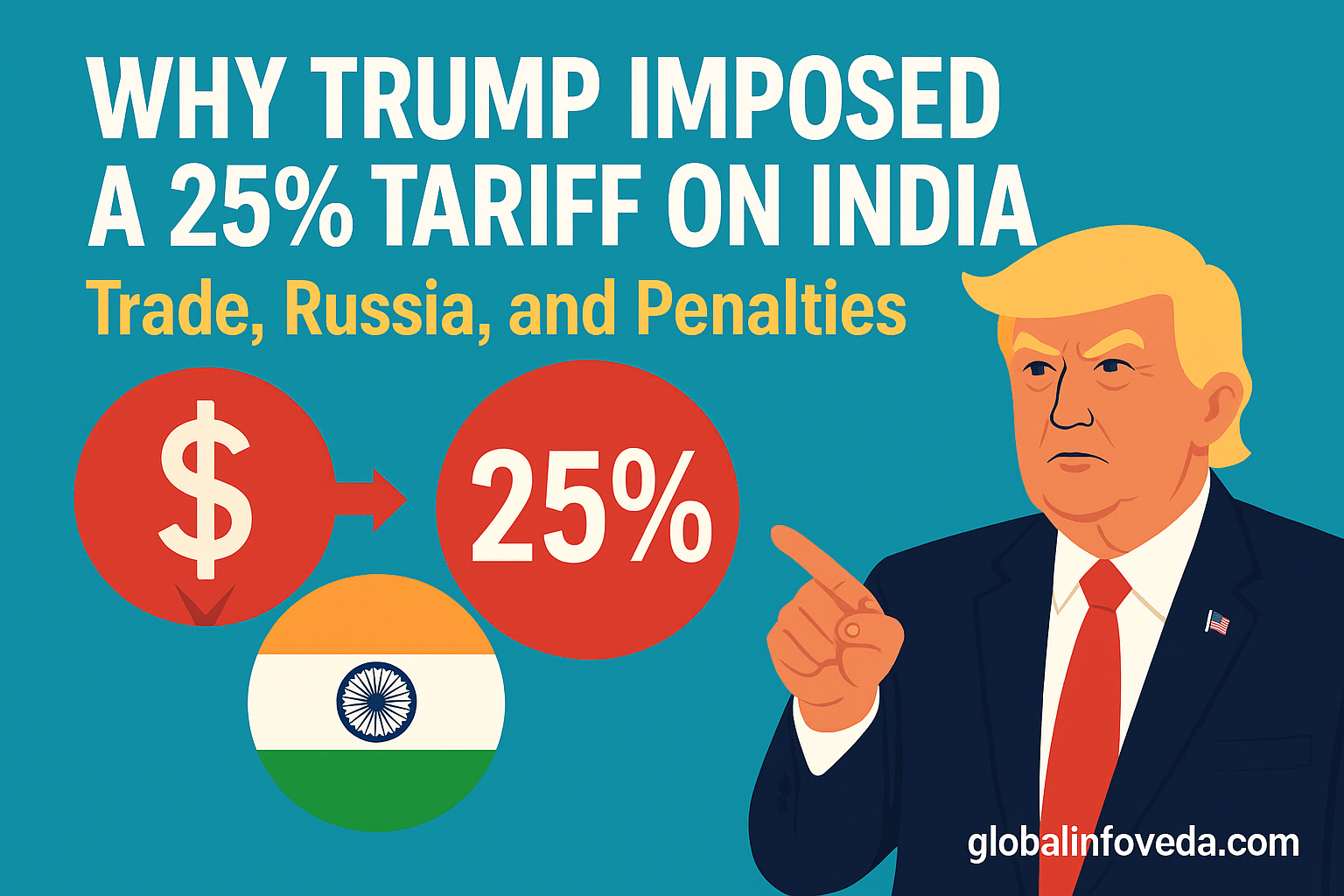Trump Imposed a 25% Tariff on India: Trade, Russia, and Penalties
In mid-2025, Donald Trump, now a leading Republican presidential candidate once again, announced a sweeping 25% blanket tariff on all Indian exports to the United States. While the announcement caught global headlines for its audacity, a deeper look reveals that this is not merely about numbers on trade sheets. It’s a multi-layered policy maneuver with roots in economic populism, geopolitical positioning, energy alliances, election-year strategy, and global currency shifts.
This policy, though not yet fully ratified by Congress, has already started reshaping the India-U.S. trade narrative, unsettling industries, rattling global markets, and opening conversations about the long-term direction of U.S. diplomacy.
📦 Trade Deficit and the Revival of ‘America First’
The core justification given by Trump’s campaign is the ballooning U.S. trade deficit with India, which reached a record $58 billion by Q2 of 2025. Indian exports to the U.S. include pharmaceuticals, software, textiles, automotive parts, gems, and electronics—categories where India offers deep price advantages due to lower labor costs and government subsidies.
Trump’s Objectives:
- Reignite U.S. industrial zones suffering from post-pandemic stagnation
- Leverage tariffs as a short-term fix for structural imbalances in trade agreements
- Remind voters of his pre-pandemic gains in reviving U.S. factories and job numbers
Policy Fallout:
- Key Indian sectors like textiles (Tirupur), pharma (Hyderabad), and auto components (Pune) brace for supply chain shocks
- American importers, retailers, and small businesses that depend on Indian goods face rising costs, prompting fears of inflation
- India may retaliate with tariffs on U.S. agricultural products, aircraft components, and tech services
🛰️ Russia, Oil Deals & De-Dollarization as the Underlying Trigger
Beyond simple trade metrics lies a complex realignment in global energy and currency systems. Since 2022, India has:
- Tripled its oil imports from Russia, paying partially in INR and digital currency settlements
- Entered energy agreements under the BRICS Pay system, threatening SWIFT dominance
- Announced cooperation on Arctic energy corridors and joint fuel refining projects
Strategic Flashpoints for U.S.:
- Trump advisors see this as a systemic challenge to petrodollar supremacy
- India’s neutral stance on Russia is viewed as weakening NATO-led diplomatic efforts
- Washington fears a parallel economy rising from China-Russia-India-Iran trilateral alignments
The tariff thus doubles as an economic warning shot and a symbolic line in the sand: play by U.S.-centric global rules, or pay the price.
💼 Domestic Politics: The Swing-State Appeal
The domestic political optics cannot be overstated. With 2025 shaping into a high-stakes electoral rematch, Trump is targeting specific swing-state constituencies:
Electoral Strategy:
- Rust Belt states (Michigan, Pennsylvania) appreciate visible moves to protect manufacturing
- Farmers in Iowa and Ohio support tariffs when framed as protecting U.S. food systems from trade retaliation
- Evangelical voter blocs respond well to tough-on-foreign-policy rhetoric
Media Messaging:
- Conservative talk shows and right-wing influencers have framed India as “ungrateful despite U.S. partnership”
- The tariff becomes a centerpiece in Trump’s debate soundbites against Biden’s foreign policy
🌏 Trade as Geopolitical Chess
Trump’s philosophy contrasts sharply with multilateral diplomacy. This tariff signals a return to transactional foreign policy:
Broader Geopolitical Messages Embedded in the Tariff:
- To India: curb Russian trade, ease U.S. market access, or face increasing economic hurdles
- To China: the U.S. will not tolerate rising middle powers replacing American influence
- To Europe: the U.S. will lead unilaterally if allies hesitate
India’s Dilemma:
- Accept the punitive measures and attempt renegotiation under pressure
- Diversify further toward ASEAN, UAE, Europe, and African markets, reducing dollar dependency
- Accelerate BRICS-led trade zones and alternative payment systems
🔍 Additional Factors Behind the Tariff
- Tech & Data Localization
- U.S. companies like Meta and Amazon have faced regulatory barriers in India, including forced local server storage
- Trump sees this as digital protectionism
- Intellectual Property Disputes
- Trump’s advisors argue that Indian generic drug exports violate fair patent licensing models
- Hollywood and software firms continue to raise piracy complaints
- Environmental Standards
- India’s reluctance to adopt U.S.-style carbon disclosure frameworks is seen as trade evasion
- Trump uses this to frame the tariff as a “green tax parity mechanism”
- India’s Tech Rise
- India’s rise in chip design, AI, and drone manufacturing directly competes with U.S. emerging sectors
- The tariff may be a hedge against tech displacement in the 2030s
🧠 Final Insight
Trump’s 25% tariff is far more than a trade tool—it’s a multi-front weapon deployed at the intersection of economic pressure, strategic realignment, and electoral theatrics. It forces India to choose between alignment and autonomy at a time when New Delhi is striving to define its own independent global path.
From SWIFT bypass to Russian oil, from trade asymmetry to regional hegemony, this tariff is not just about “Made in America.” It’s about defining who writes the rules of global trade in the next decade.
🌐 Stay updated on geopolitics, trade dynamics, and policy shifts at GlobalInfoVeda.com
